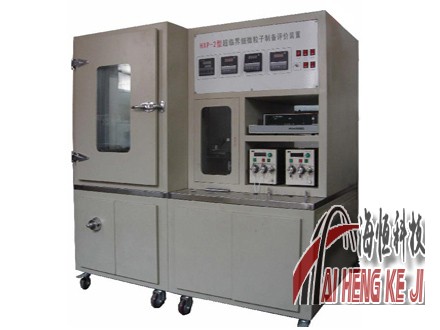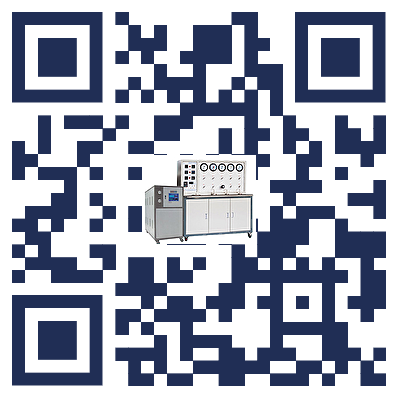一、概述
超临界流体沉析技术是利用SCF所具有的特殊性质,在一定的条件下使溶液达到极高的过饱和度与过饱和速率,从而使溶质迅速沉析,形成超细微粒。这种方法能够更准确地控制结晶过程形成平均粒径很小的超细微粒,且可以控制产品的粒度分布。与传统的粉碎及结晶技术相比,使用超临界流体可避免大量使用有机溶剂及由此而造成的环境污染和除去产品中残留有机溶剂的繁琐步骤,并可用于热敏性、结构不稳定及易失活变性的物品。
ASES过程与GAS过程不同之处:在ASES过程中颗粒形成与干燥同时进行,形成的颗粒中残余的有机溶剂含量少。而GAS过程的结晶沉淀过程都是在液相中发生的,需要经过长时间的洗涤操作才能得到干燥的固体颗粒。
SEDS过程(超临界流体强化溶液分散的沉淀过程)是将超临界CO2、含有溶质的溶液和有机溶剂一起喷入结晶器,并经短暂的接触和混合过程。由于有机溶剂大大高于溶质水溶液的流量,使二者接触混合后溶质迅速析出,而高压CO2的流量又大大高于有机溶剂的流量,使溶液和有机溶剂混合后立即被高速喷射的CO2冲散为液滴,与此同时液滴中少量的有机溶剂和水迅速溶于CO2之中,使析出的溶质颗粒得以快速干燥。海恒科研仪器生产的超临界细微粒子制备装置根据要求进行具体的配置。
二、主要技术参数:
结晶器工作压力:≤30MPa
结晶方式:根据要求进行设计
工作温度:室温-150℃
预热温度:≤85℃
结晶器容积:200mL-2L
分离结构:旋风分离设计
三、系统组成及技术指标:
该装置由以下几部分组成:CO2供应系统、内含溶质的溶液进料系统、有机溶剂进料系统、结晶器、卸压装置、控温系统(采用恒温箱空气浴加热)、安全保护系统组成。
1、CO2供应系统
由CO2钢瓶、净化器、制冷系统、CO2柱塞泵、缓冲罐、预热盘管及相应管阀件组成。
净化器:容积200mL,设计压力8MPa,内部充满分子筛或硅胶,可过滤杂质及水分,内部过滤网目数为400目(相当于38μm)。
制冷系统:用于将气态CO2制冷变成液态CO2。规格根据结晶器大小进行配置。
CO2柱塞泵:工作压力≤30MPa,额定压力≤40MPa,流量根据结晶器进行配置。
缓冲罐:用于结晶器前CO2的缓冲,减少脉流。容积200mL,工作压力≤30MPa。
预热盘管:用于结晶器前CO2的预热,保持进入结晶器超临界流体的温度稳定。
2、内含溶质的溶液进料系统:由玻璃杯、柱塞泵及相应管阀件组成。
柱塞泵:工作压力≤30MPa,额定压力≤40MPa,流量根据结晶器进行配置。
3、有机溶剂进料系统:由玻璃杯、柱塞泵及相应管阀件组成,这是为SEDS过程特殊设计。
柱塞泵:工作压力≤30MPa,额定压力≤40MPa,流量根据结晶器进行配置。
4、结晶器:容积为根据要求进行配置,入口接有喷嘴,喷嘴用不锈钢制作,激光穿孔,长度 与内径之比为15:1,喷嘴内径规格有60μm、80μm、100μm,120μm可根据实验需要选用。
结晶器内部喷嘴根据要求进行配置单头喷嘴或可调节喷嘴。单头喷头结构形式主要在GAS法、ASES法(即PCA法)使用。
5、卸压罐:容积为100mL,设计压力20MPa,主要用于气液分离。
6、恒温箱:工作室尺寸为500(长)×500(宽)×600(深),采用温控仪控温,恒温箱内装加热器及循环风扇,热交换采用对流和辐射传热,工作室均为不锈钢内胆,设计新颖,外形美观,结构紧凑合理。
7、安全保护系统:为保证系统的安全,我们设计了安全保护系统,主要由电接点压力表和安全阀组成,电接点压力表控制压力源(柱塞泵)的压力,可设定上限压力,可避免超压现象。另外结晶器上安装有安全阀,可实施溢流保护。
I. Overview
Supercritical fluid precipitation technology is to use the special properties of SCF to make the solution reach extremely high supersaturation and supersaturation rate under certain conditions, so that the solute can precipitate quickly and form ultrafine particles. This method can more accurately control the formation of ultrafine particles with very small average particle size in the crystallization process, and can control the particle size distribution of products. Compared with the traditional crushing and crystallization technology, the use of supercritical fluid can avoid the use of a large number of organic solvents and the resulting environmental pollution and the tedious steps of removing residual organic solvents in products, and can be used for articles with heat sensitivity, unstable structure and easy inactivation and denaturation.
The difference between ASES process and GAS process is that particle formation and drying are carried out at the same time in ASES process, and the residual organic solvent content in the formed particles is less. However, the crystallization and precipitation process in GAS process takes place in liquid phase, and it takes a long time to get dry solid particles.
SEDS process (precipitation process with enhanced solution dispersion by supercritical fluid) is a process in which supercritical CO2, solute-containing solution and organic solvent are sprayed into the crystallizer together, and they are contacted and mixed for a short time. Because the flow rate of organic solvent is much higher than that of solute aqueous solution, the solute is rapidly precipitated after the two are mixed, and the flow rate of high-pressure CO2 is much higher than that of organic solvent, so that the solution and organic solvent are immediately dispersed into droplets by CO2 sprayed at high speed after mixing, and at the same time, a small amount of organic solvent and water in the droplets are quickly dissolved in CO2, so that the precipitated solute particles can be quickly dried. The supercritical fine particle preparation device produced by Haiheng scientific research instrument is configured according to the requirements.
Second, the main technical parameters:
Working pressure of crystallizer: ≤30MPa
Crystallization mode: design according to requirements.
Working temperature: room temperature -150℃
Preheating temperature: ≤85℃
Crystallizer volume: 200mL-2L
Separation structure: cyclone separation design
Third, the system composition and technical indicators:
The device consists of the following parts: CO2 supply system, solution feeding system containing solute, organic solvent feeding system, crystallizer, pressure relief device, temperature control system (heated by air bath in constant temperature box) and safety protection system.
1. CO2 supply system
It consists of a CO2 steel cylinder, a purifier, a refrigeration system, a CO2 plunger pump, a buffer tank, a preheating coil and corresponding pipe valves.
Purifier: The volume is 200mL, the design pressure is 8MPa, the inside is filled with molecular sieve or silica gel, which can filter impurities and moisture, and the mesh number of the internal filter screen is 400 meshes (equivalent to 38μm).
Refrigeration system: used to refrigerate gaseous CO2 into liquid CO2. Specifications are configured according to the size of crystallizer.
CO2 piston pump: working pressure ≤30MPa, rated pressure ≤40MPa, and flow rate is configured according to crystallizer.
Buffer tank: used for buffering CO2 before crystallizer to reduce pulse flow. The volume is 200mL, and the working pressure is ≤30MPa.
Preheating coil: used for preheating CO2 before crystallizer to keep the temperature of supercritical fluid entering crystallizer stable.
2. Solution feeding system containing solute: It consists of glass, plunger pump and corresponding pipe valves.
Piston pump: working pressure ≤30MPa, rated pressure ≤40MPa, and flow rate is configured according to crystallizer.
3. Organic solvent feeding system: it consists of glass, plunger pump and corresponding pipe valves, which is specially designed for SEDS process.
Piston pump: working pressure ≤30MPa, rated pressure ≤40MPa, and flow rate is configured according to crystallizer.
4. Crystallizer: The volume is configured according to the requirements, and the inlet is connected with a nozzle. The nozzle is made of stainless steel and perforated by laser. The ratio of length to inner diameter is 15: 1. The specifications of inner diameter of the nozzle are 60μm, 80μm and 100μm, and 120μm can be selected according to the experimental requirements.
The nozzles in the crystallizer are configured with single-head nozzles or adjustable nozzles as required. The structure of single-head nozzle is mainly used in GAS method and ASES method (PCA method).
5. Pressure relief tank: with a volume of 100mL and a design pressure of 20MPa, it is mainly used for gas-liquid separation.
6. Thermostatic box: The size of the working room is 500 (length) ×500 (width) ×600 (depth), and the temperature is controlled by a thermostat. The thermostat is equipped with a heater and a circulating fan, and the heat exchange adopts convection and radiation heat transfer. The working rooms are all stainless steel liners, with novel design, beautiful appearance and compact and reasonable structure.
7. Safety protection system: In order to ensure the safety of the system, we designed a safety protection system, which is mainly composed of an electric contact pressure gauge and a safety valve. The electric contact pressure gauge controls the pressure of the pressure source (plunger pump), and can set the upper limit pressure to avoid overpressure. In addition, a safety valve is installed on the crystallizer to implement overflow protection.






 客服1
客服1